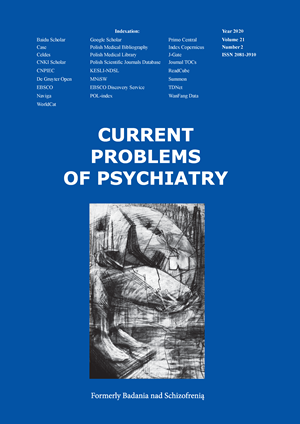Drug-induced dyskinesias, can they be prevented?
DOI:
https://doi.org/10.2478/cpp-2020-0009Keywords:
drug-induced dyskinesias, neuroleptics, dystoniaAbstract
Introduction. Dyskinesia is a symptom complex in the form of involuntary, repetitive movements of lips, lower jaw, tongue, less often the trunk and limbs. Despite the use of newer drugs in treatment neuroleptics, dyskinesia has not ceased to be a clinical problem.
Method. The work is based on a research review for which the Google Scholar database was used as well PubMed. The search range was limited to 2008-2020. We have included descriptive publications tardive dyskinesia only as a consequence of antipsychotic medications.
Material. We present the use of tetrabenazine analogues, deep brain stimulation, neuroleptics, benzodiazepines and botulinum toxin in late-suffering patients drug-induced dyskinesias, which may indicate an improvement in your health.
Discussion. The first method of treating tardive dyskinesia are withdrawal antipsychotic medications, but for many patients this is impossible. Valbenazine and Deep Brain Stimulation are the most effective in treating Tardive Dyskinesia.
Conclusions. There are not enough studies with the highest reliability to create unequivocal recommendations in the treatment of drug-induced tardive dyskinesia.
References
1. Mosiołek A. Objawy pozapiramidowe w psychiatrii − diagnostyka i leczenie. Psychiatria 2014;11(3):160-165.
2. Sapa J. Wybrane choroby i zaburzenia polekowe – możliwości profilaktyki i leczenia. Część I. Farm. Pol. 2009; 65 (10): 733-742.
3. Sławek J, Białecka M, Dudek D, Koziorowski D, Rudzińska-Bar M. Późne dyskinezy polekowe − rekomendacje grupy ekspertów. Pol. Przegl. Neurol 2017;13(3):93-105.
4. Patel RS, Mansuri Z, Motiwala F, et al. A systematic review on treatment of tardive dyskinesia with valbenazine and deutetrabenazine. Ther Adv Psychopharmacol. 2019;9:2045125319847882. doi:10.1177/2045125319847882
5. Kane JM. Tardive dyskinesia rates with atypical antipsychotics in adults: prevalence and incidence. 2004; 65, 9: 16–20.
6. Waln O, Jankovic J. An update on tardive dyskinesia: from phenomenology to treatment. Tremor Other Hyperkinet Mov (NY). 2013;3:tre-03-161-4138-1. doi:10.7916/D88P5Z71
7. D'Abreu A, Akbar U, Friedman JH. Tardive dyskinesia: Epidemiology. J Neurol Sci. 2018;389:17-20. doi:10.1016/j.jns.2018.02.007
8. Haile K, Umer H. The use of clozapine and clonazepam co-administration in the treatment of a severe tardive dyskinesia: A case report. SAGE Open Med Case Rep. 2019;7:2050313X19833254. doi:10.1177/2050313X19833254
9. Caroff SN, Aggarwal S, Yonan C. Treatment of tardive dyskinesia with tetrabenazine or valbenazine: a systematic review. J Comp Eff Res. 2018;7(2):135-148. doi:10.2217/cer-2017-0065
10. Caroff SN. Overcoming barriers to effective management of tardive dyskinesia. Neuropsychiatr Dis Treat. 2019;15:785-794. doi:10.2147/NDT.S196541
11. Macerollo A, Deuschl G. Deep brain stimulation for tardive syndromes: Systematic review and meta-analysis. J Neurol Sci. 2018;389:55-60. doi:10.1016/j.jns.2018.02.013
12. Deng ZD, Li DY, Zhang CC, et al. Long-term follow-up of bilateral subthalamic deep brain stimulation for refractory tardive dystonia. Parkinsonism Relat Disord. 2017; 41: 58-65. doi:10.1016/j.parkreldis.2017.05.010.
13. Bhidayasiri R, Jitkritsadakul O, Friedman JH, Fahn S. Updating the recommendations for treatment of tardive syndromes: A systematic review of new evidence and practical treatment algorithm. J Neurol Sci. 2018;389:67-75. doi:10.1016/j. jns.2018.02.010
14. Aguilar L, Lorenzo C, Fernández-Ovejero R, Roncero C, Montejo AL. Tardive Dyskinesia After Aripiprazole Treatment That Improved With Tetrabenazine, Clozapine, and Botulinum Toxin. Front Pharmacol. 2019;10:281. doi:10.3389/fphar.2019.00281
15. Bergman H, Bhoopathi PS, Soares-Weiser K. Benzodiazepines for antipsychotic-induced tardive dyskinesia. Cochrane Database Syst Rev. 2018;1(1):CD000205. doi:10.1002/14651858. CD000205.pub3.
16. Chatterjee, Anjan MD; Forrest Gordon, Mark MD; Giladi, Nir MD; Trosch, Richard MD Botulinum Toxin in the Treatment of Tardive Dystonia. Journal of Clinical Psychopharmacology. 1997; 17(6): 497-498
17. Slotema CW, van Harten PN, Bruggeman R, Hoek HW. Botulinum toxin in the treatment of orofacial tardive dyskinesia: a single blind study. Prog Neuropsychopharmacol Biol Psychiatry. 2008;32(2):507-509. doi:10.1016/j.pnpbp.2007.10.004
18. Cornett EM, Novitch M, Kaye AD, Kata V, Kaye AM. Medication-Induced Tardive Dyskinesia: A Review and Update. Ochsner J. 2017;17(2):162-174.
19. Cloud LJ, Zutshi D, Factor SA. Tardive dyskinesia: therapeutic options for an increasingly common disorder. Neurotherapeutics. 2014;11(1):166-176. doi:10.1007/s13311- 013-0222-5.
Downloads
Published
Issue
Section
License
Copyright (c) 2020 Authors

This work is licensed under a Creative Commons Attribution 4.0 International License.


